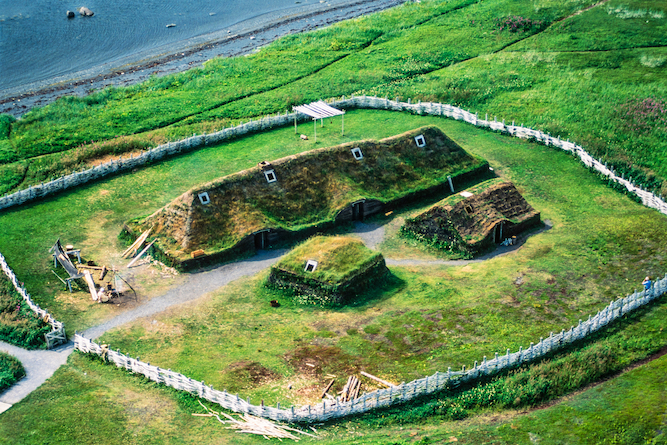Centuries before Christopher Columbus stumbled across the Bahamas, the Vikings established a beachhead at L’Anse Aux Meadows, a site on the northern peninsula of what is now Newfoundland, Canada. A recent study narrows down the date of the Norse arrival in North America to as early as 1021 CE, based on scraps of discarded wood from the site and with help from the aftermath of an ancient solar storm.
Vikings and cosmic rays
In the early 1200s, Icelandic authors wrote down two sagas describing Norse explorers’ trips to a place called Vinland. The expeditions had happened about two centuries earlier. Based on those sagas and the types of artifacts left behind at L’Anse aux Meadows, archaeologists today generally agree that the Norse arrived sometime near the end of the 1st millennium CE. For a few years (between three and 10), the Norse settlers used the site as a base for explorations farther south—and then they left.
Radiocarbon dating of charcoal from L’Anse aux Meadows suggests that the Viking Age came to American shores sometime between 975 and 1020 CE. To narrow down when the Norse arrived in Newfoundland, University of Groningen chronologists Michael Dee and Margot Kuitems, along with their colleagues, looked for evidence of the year a solar storm bombarded Earth’s atmosphere with radiation.
In late 992 and early 993 CE, people in Korea, Germany, and Ireland all mentioned vibrant red auroras dancing in the night sky. Trees around the world trapped an unusually high amount of carbon-14 in their growth rings the following year. Carbon-14 forms in the upper atmosphere when highly energized particles called cosmic rays collide with nitrogen molecules. Usually, those cosmic rays come from events outside our Solar System, toward the center of the Milky Way galaxy, but physicists blame the 993 CE event on our own Sun.
Dendrochronologists (scientists who measure and date tree rings) discovered the carbon-14 spike and dated it to 993 CE in trees from sites around the world. Dee, Kuitems, and their colleagues recently used it as a landmark to help pinpoint the age of three wood fragments from L’Anse aux Meadows.
The fragments, which come from three different trees (a mixture of juniper and fir), were cast-off cuts of wood discarded by the Norse, but all still bear cut marks from iron tools. “We imagine they were refuse from construction projects or indeed just the clearance of land,” Dee told Ars.
All three wood fragments included at least part of a tree’s outermost ring (tree-ring enthusiasts call this the "waney layer"). That confirmed the fragments came from felled trees, not driftwood, whose bark would have been stripped away by the ocean. It also meant that Dee, Kuitems, and their colleagues could date the exact year the trees were cut down.
A thousand years ago
The outer layers of all three fragments dated from between 1019 and 1024 CE. That precision was possible thanks in part to the IntCal20 calibration curve, which is the first radiocarbon calibration curve to break down changes in atmospheric carbon levels into single-year increments.
“Our long, single-year sequences could in the end be quite precisely matched to this single-year calibration (reference) record,” Dee told Ars. And that told Dee, Kuitems, and their colleagues that they needed to count back 26 to 31 rings to find the one that formed during the year of the solar storm, 993 CE. Once they had found 993 CE, they simply counted forward again to the final growth ring.
And for all three artifacts, that final year was 1021 CE.
“The fact that our results, on three different trees, converge on the same year is striking and unexpected,” wrote Dee, Kuitems, and their colleagues. “This coincidence strongly suggests Norse activity at L’Anse aux Meadows in 1021 CE.” The Norse may have been at the site slightly earlier, but they were definitely there and cutting down trees by 1021.
Based on the development stages of certain cells in the waney layer, Dee, Kuitems, and their colleagues say that one of the trees was cut down in the spring, while another was cut down in the summer or fall. The third tree’s final season couldn’t be identified because the cells had been damaged by a conservation treatment, but the results suggest that the Norse cut down these trees within a few months of each other in 1021.
That lends additional support to the other evidence that the Norse only stayed in Newfoundland for a few years.
“One would imagine the dates would have been different if the occupation period of the site was very long,” Dee told Ars. “However, the fact all three of our samples produced the same date does not, of course, mean the site was only occupied for one year. It may indeed have been occupied longer. But I think it is true to say our results support a short occupation.”
A timeline of the Viking Age
Dee, Kuitems, and their colleagues used the same method—but this time with a radiocarbon spike in 775 CE—to date a Uyghur monument in Russia last year.
Now, the researchers hope to date more L’Anse aux Meadows artifacts, which could narrow down exactly how long the Norse stayed at the site. Dee told Ars that the team would also like to date materials from several other North American places suggested as Viking sites despite a lack of clear evidence so far.
Meanwhile, a more precise date for L’Anse aux Meadows could help historians and archaeologists better understand how the site fits into the broader timeline of the Viking Age—but that will require more work. “It is a matter for future research how the year 1021 CE relates to overall trans-Atlantic activity by the Norse,” wrote Dee, Kuitems, and their colleagues.
Nature, 2021 DOI: 10.1038/s41586-021-03972-8 (About DOIs).


